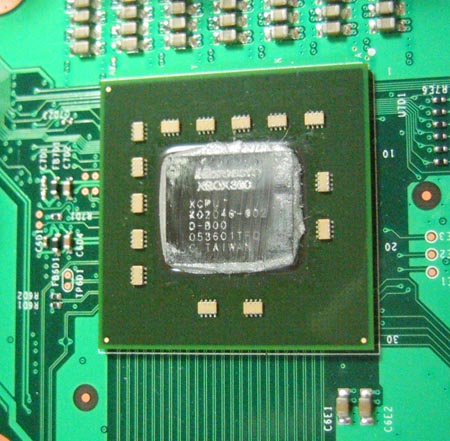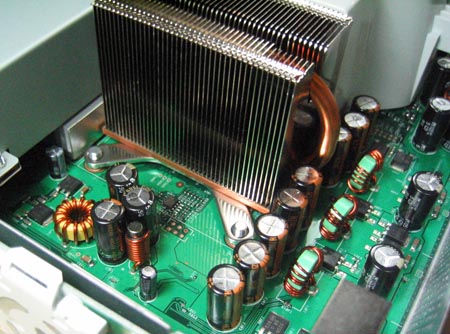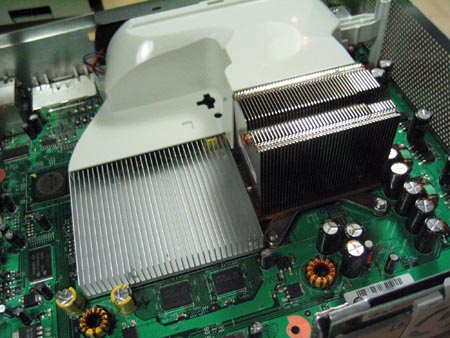Inside Microsoft's Xbox 360
by Anand Lal Shimpi, Kristopher Kubicki & Tuan Nguyen on November 16, 2005 5:09 AM EST- Posted in
- Systems
The Xbox 360 CPU
The original Xbox used a hybrid mobile Pentium III/Celeron processor, but for the 360 Microsoft went to IBM and got the rights to a PowerPC core. The move to the PowerPC instruction set meant that there would be no direct binary compatibility with older Xbox titles, but the sacrifice was obviously deemed necessary by Microsoft.
The CPU itself features three of these PowerPC cores and is currently manufactured on a 90nm process, however Microsoft will most likely be transitioning to 65nm as soon as possible in order to reduce the die size and thus manufacturing costs. Remember that a die shrink from 90nm down to 65nm will cut the size of the CPU in half, and should be possible for Microsoft sometime before the end of next year.
All three cores are identical and feature a 2-issue pipeline and can only execute instructions in-order; we've already discussed the reasoning behind this decision here. The impact of the in-order execution cores is generally a negative one on current game code, but by going with a much simpler core Microsoft was able to stick three of them on a die with hopes of making up for lost performance by enabling some pretty serious multithreading.
Not only does the Xbox 360's CPU feature 3 cores, but each core is capable of executing two threads at the same time, making the CPU capable of simultaneously executing 6 threads. Unfortunately, most titles appear to be only using one or two threads for the majority of their game code, with the remaining threads being used for things like audio encoding/decoding, real-time decompression of game data off of the DVD-ROM and video decoding.
Microsoft has their own license to use and manufacture the CPU used in the Xbox 360, and thus we see their logo on the chip itself. Microsoft cools the 3-core CPU using a fairly beefy heatsink outfitted with heatpipes (pictured below):
Airflow is supplied by the two rear fans in the Xbox 360; the air is channeled over the GPU and CPU heatsinks using a duct. The larger heatsink on the right is atop the CPU, the smaller heatsink is for the GPU:
We have previously discussed the Xbox 360's CPU in much greater detail, which you can read about here.













91 Comments
View All Comments
Penth - Thursday, November 17, 2005 - link
In response to your second point, the XBox360 does include support for Windows Media center. That is my main point of interest as well. The latest update rollup for windows media center 2005 (was released just over a month ago) adds support for the xbox360. Notice in the picture of the remote it also has the green button.LoneWolf15 - Friday, November 18, 2005 - link
According to what I've read, that's support for a Windows Media Center PC attatched to it, not the ability to run Windows Media Center.. That's not really what I want. I want to be able to hook the thing up to a TV, insert a CD or DVD with DivX content on it, and just play back that way. Still not clear if I can do that.
Ecmaster76 - Wednesday, November 16, 2005 - link
I demand further disassemblage of the DVD!Check and see if it is a single chip SATA logic or a bridged soulution please. If its the former, I predict a surge in availability of cheap, (oem?) SATA DVD-ROMs.
Which is good news for people who like cable management or own a newer Intel mothernoard.
Xenoterranos - Thursday, November 17, 2005 - link
I was dissapointed in the RAM being soldered to the board. I was looing forward to ramming a couple gig-sticks in there.Griswold - Thursday, November 17, 2005 - link
Open case - ramm a couple sticks in - close case - shake it - done.Googer - Wednesday, November 16, 2005 - link
I went to my local Worst Buy and played call of duity 2. The graphics were cr*p with no anti-aliasing. If this is any indication of what to expect from this console then PC games and their players should have little to worry about.dj 315 - Wednesday, November 16, 2005 - link
Still it seems most have been set up incorrectlynyquistcapital - Wednesday, November 16, 2005 - link
Thanks for the close up shot of the South Bridge device. Can you provide more close ups of the 208PQFP directly above the GPU, and the other component to the left of the GPU, past the 2x DDR.Really cool stuff guys!
lymz - Wednesday, November 16, 2005 - link
The capacitors in the pictures look an awful lot like the ones that Dell and Apple are having problems with. Perhaps something worth investigating...kilkennycat - Wednesday, November 16, 2005 - link
Seems as if a fan failure (or blockage of the inlet air passage) could potentially cause catastrophic failure of the critical silicon without effective thermal protection.Anand, Kris, Tuan:-
Any idea of the nature and effectiveness of the thermal protection -- or wanna carry out a potentially destructive test by blocking up the inlet air on your presumably-rare Xbox360? An important issue for the TYPICAL technically-naive purchaser of the Xbox360, who is likely to be very careless about the Xbox360 ventilation and certainly will forget to regularly clear the inlet air-holes of sticky crud and junk. And what about the close-packed-finned heat-sink on the CPU? Such heat sinks on PC CPUs fill up completely with lint after about 6-9 months in a typical home environment. The Xbox360 is DELIBERATELY built to be non-user accessible for cleaning or any other purpose. A very big mistake. The internal air-duct should have been built on to a user-removable cover to expose the heat-sinks and fans for routine cleaning. I have had my share of cleaning out PCs that have become completely blocked up with crud, the first obvious symptom being erratic shut-down of the CPU by the motherboard thermal protection. The Xbox360 dissipates a lot of power in the core silicon --- much more than the old Xbox.
At present, I highly recommend taking a 2-year extended replacement warranty on the Xbox360, so that WHEN ( not IF) the heat-sinks fill up with junk (or the fans fail) and the box begins to function erratically, the owner can get a brand-new one :-) :-) :-)